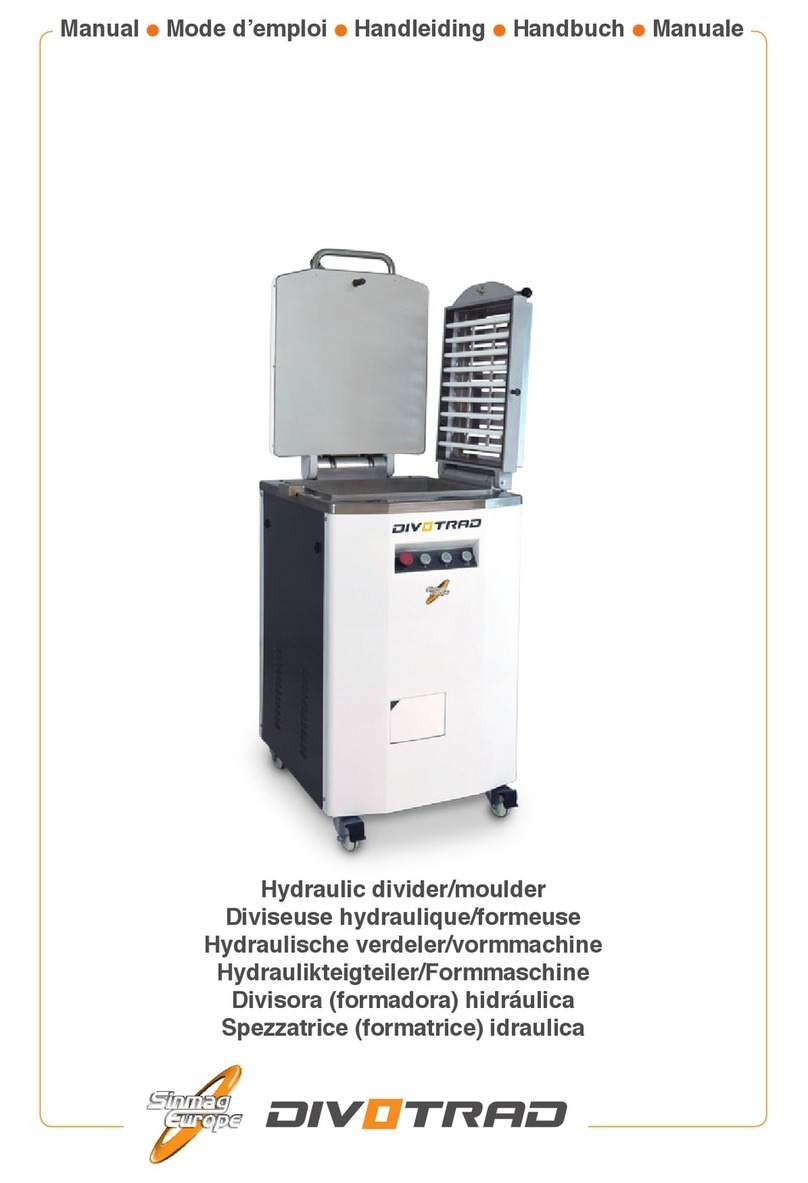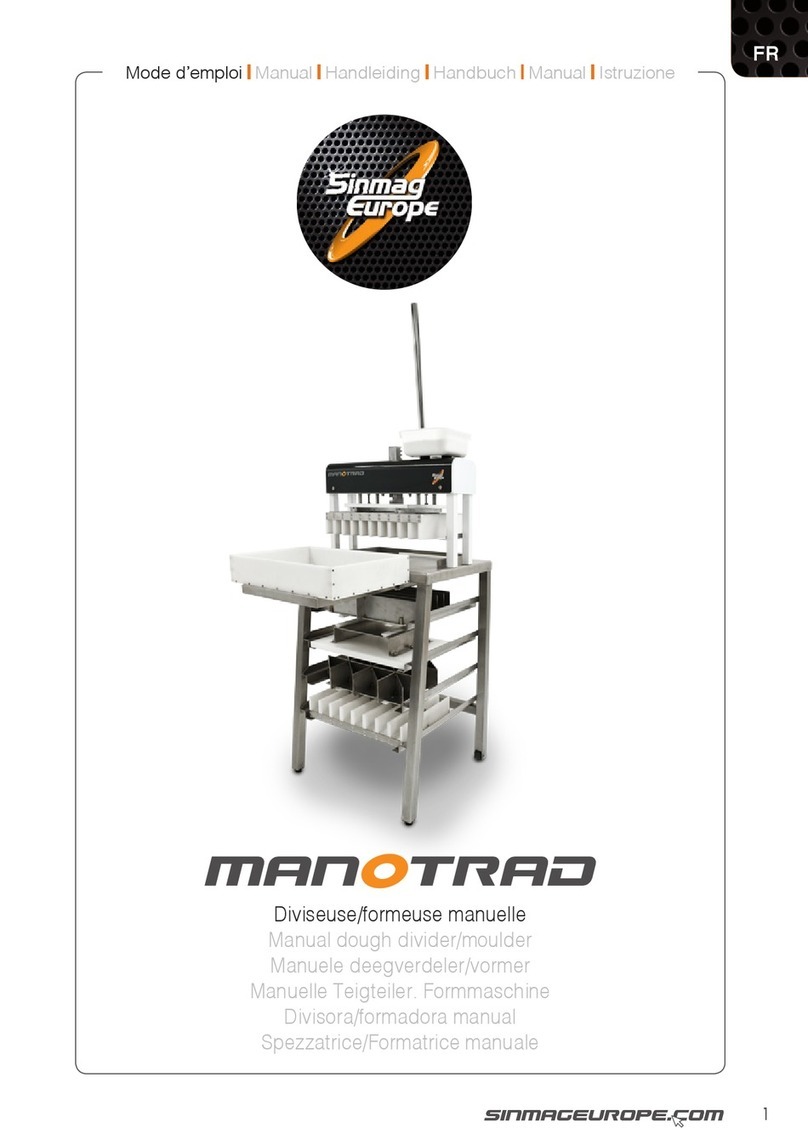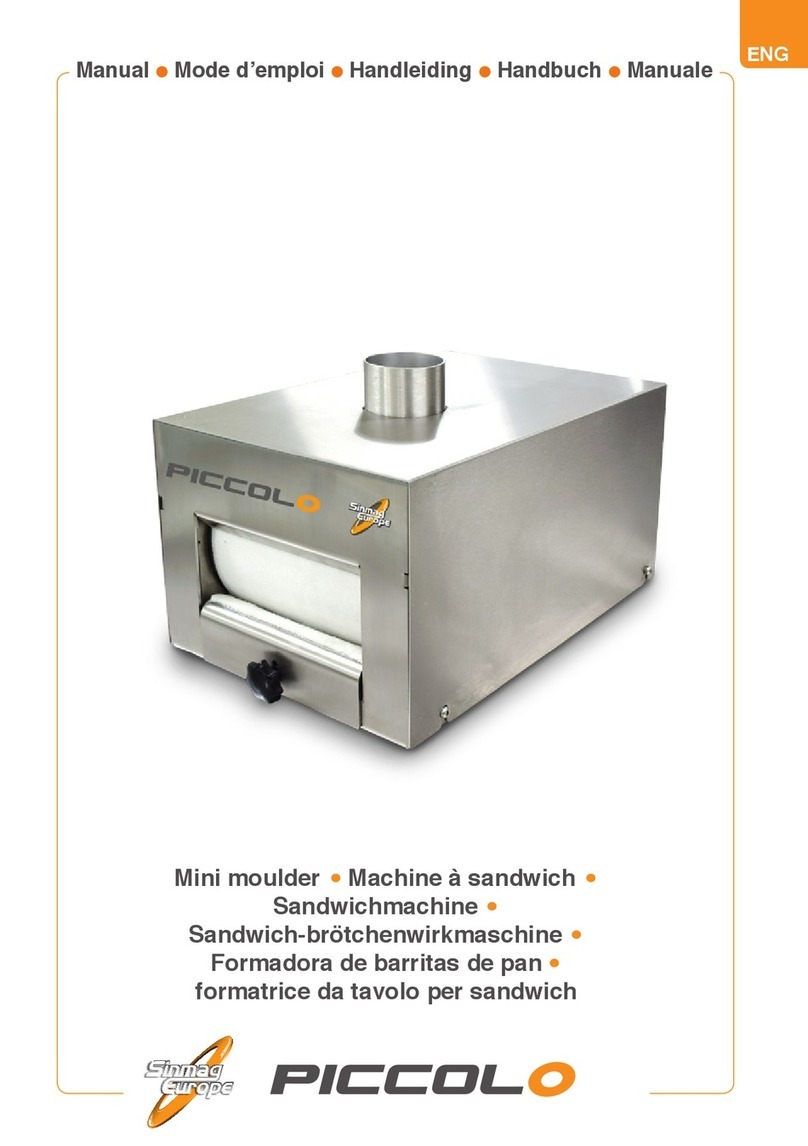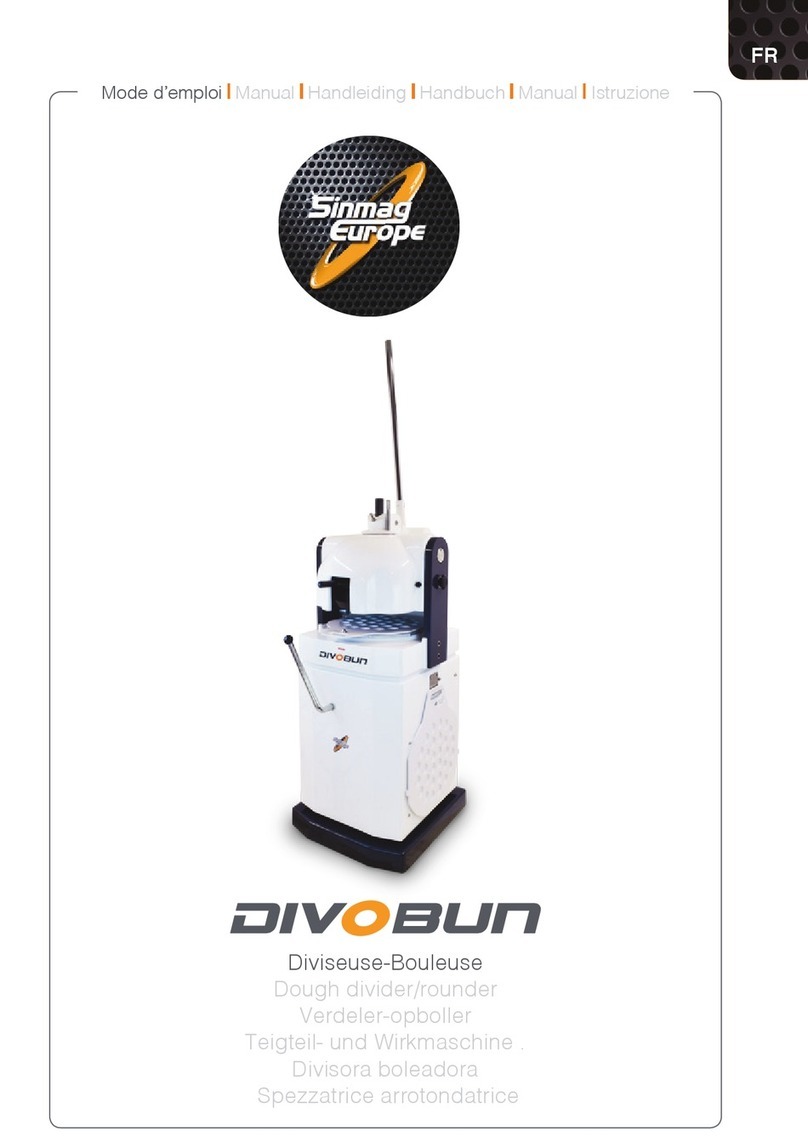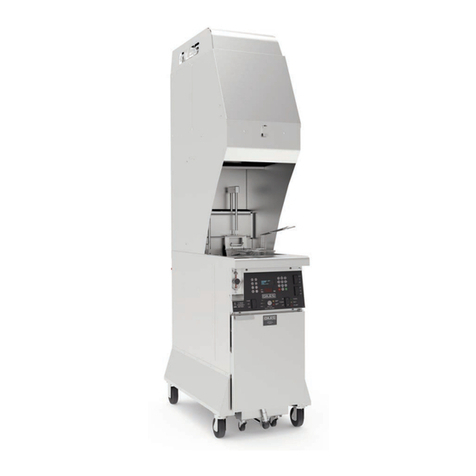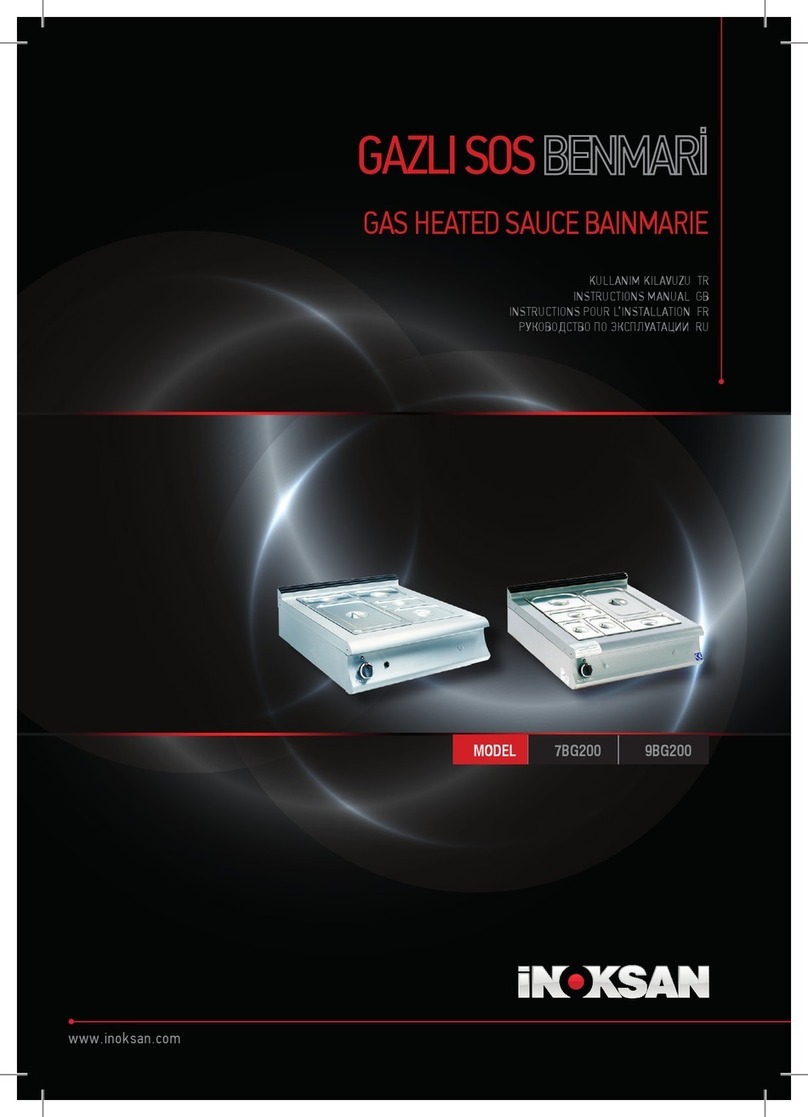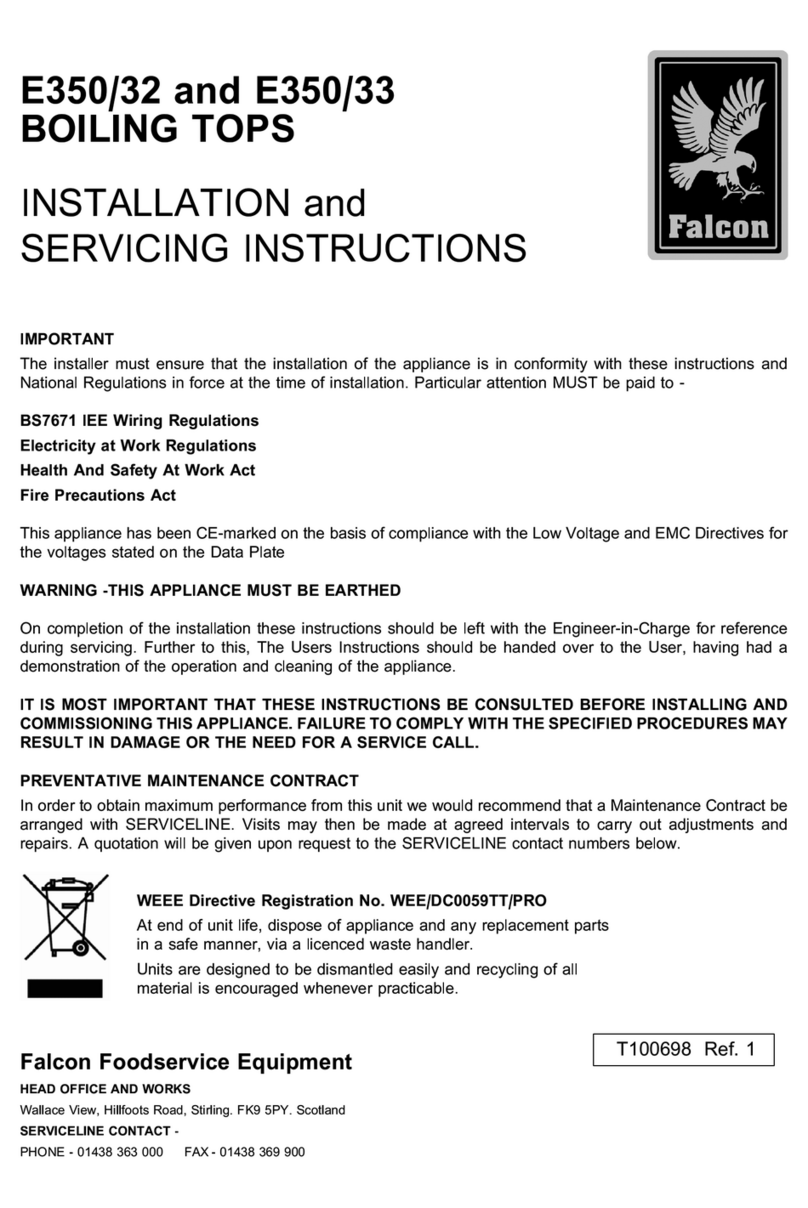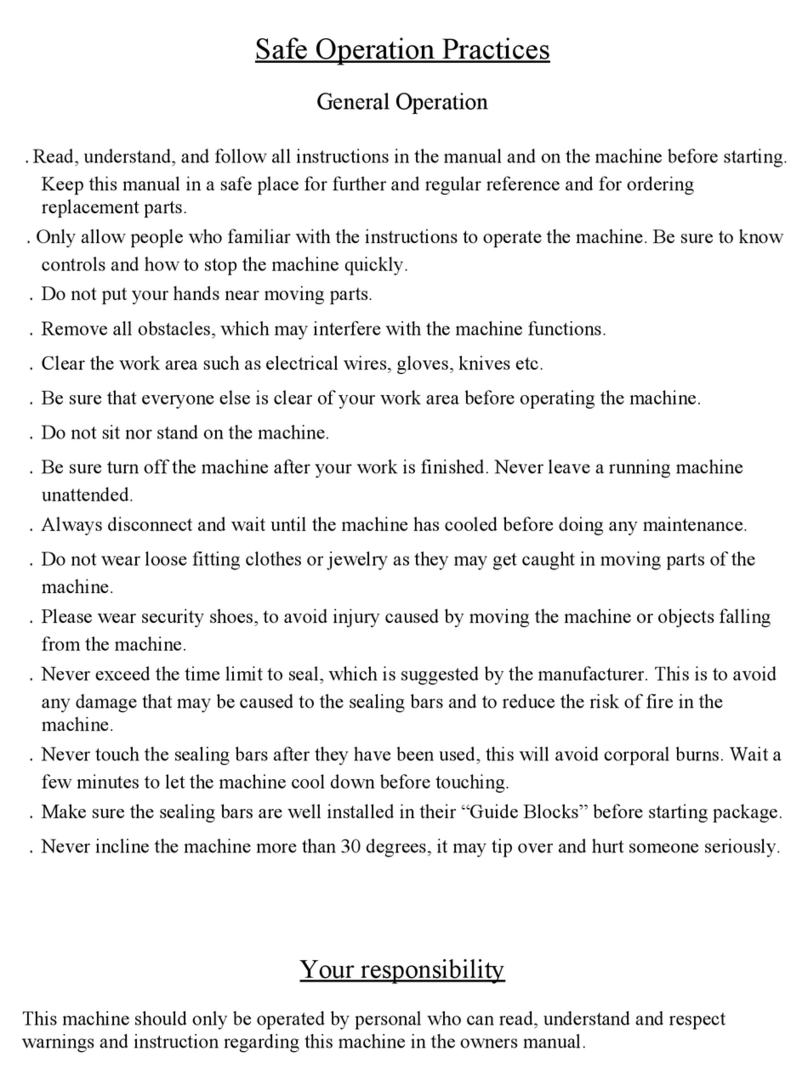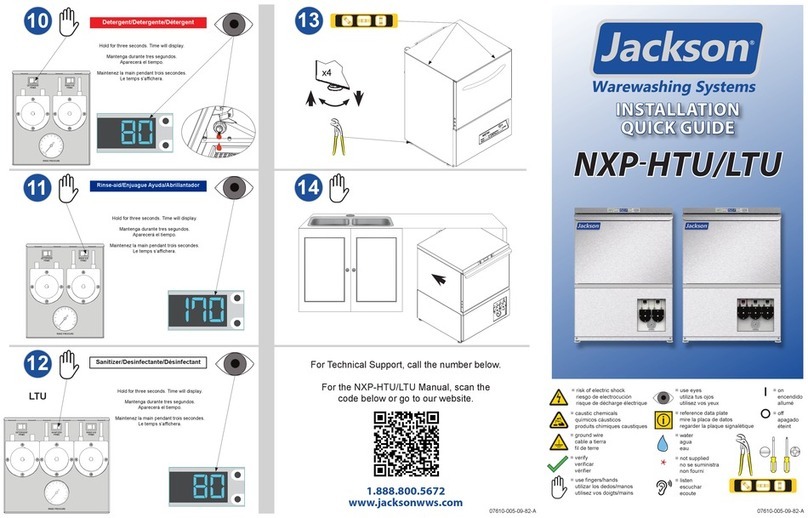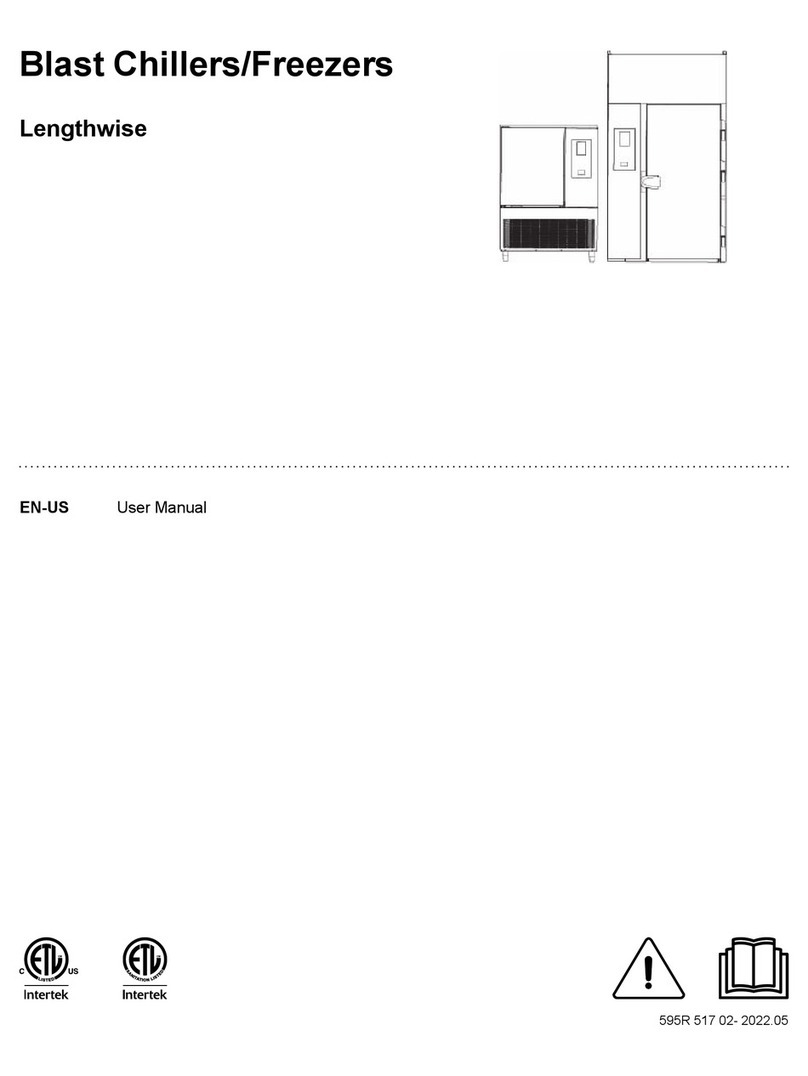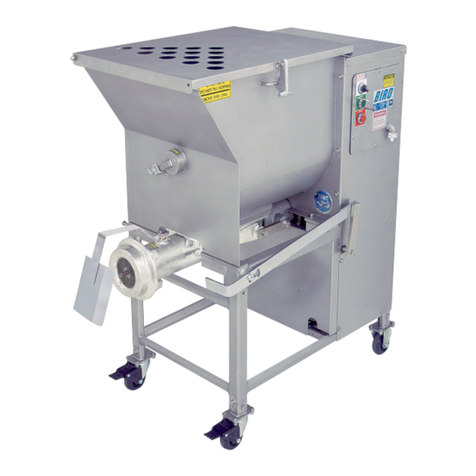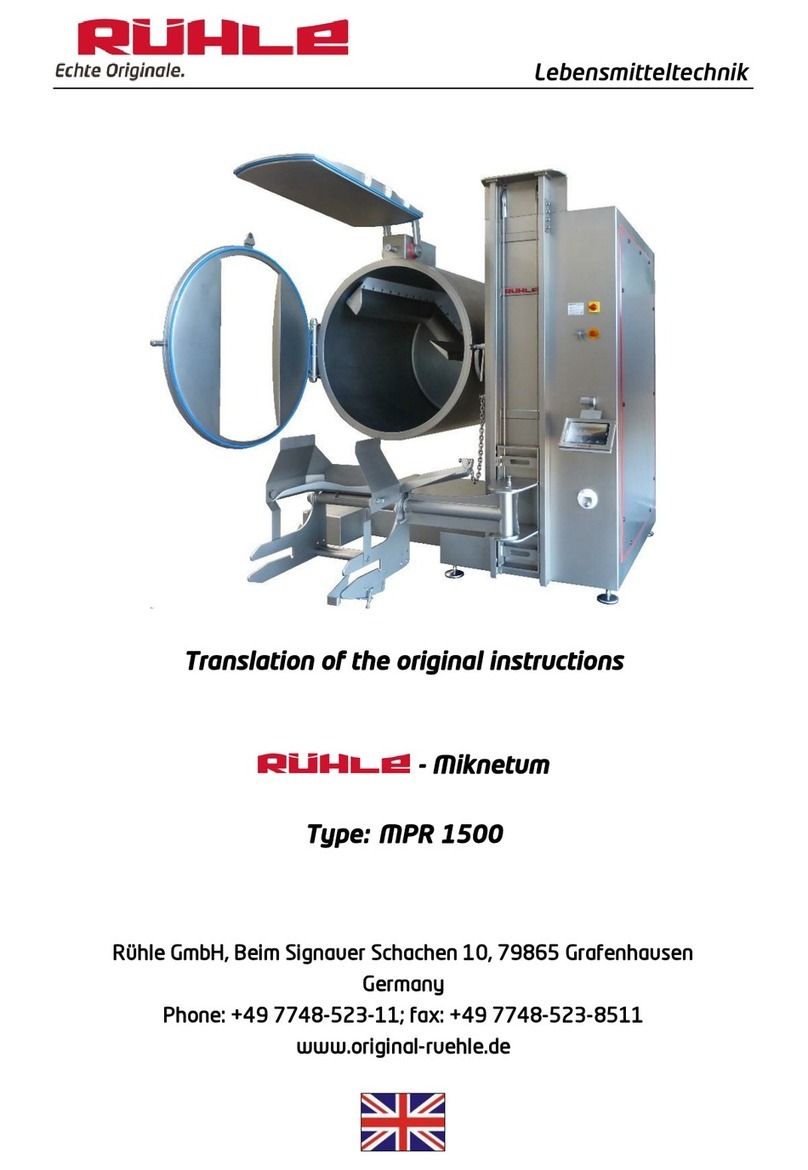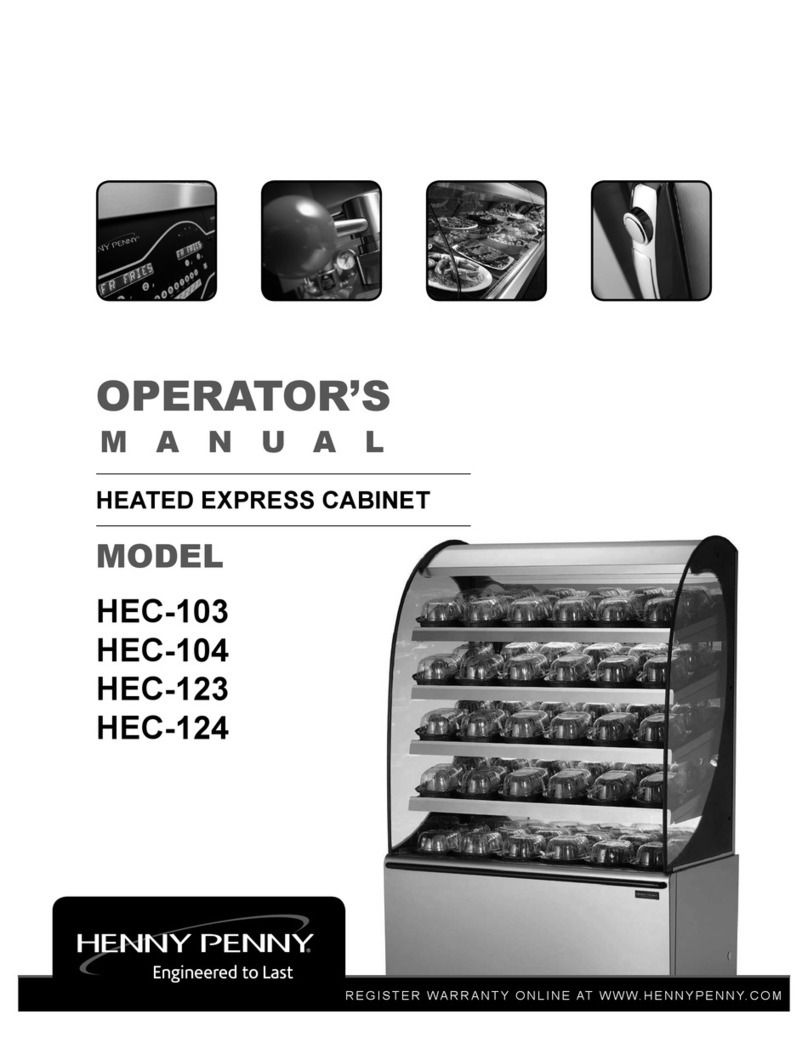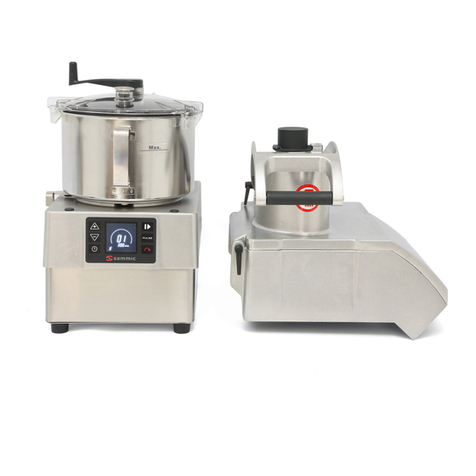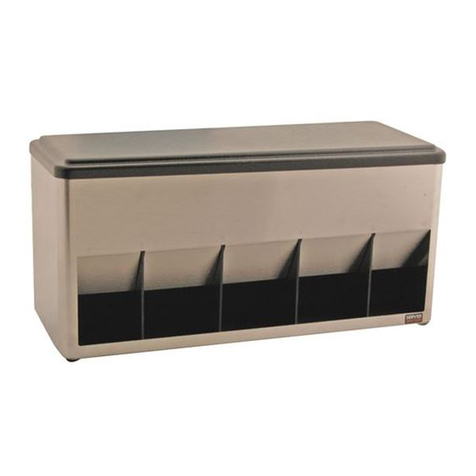Sinmag Europe DIVOBUN Series User manual

Mode d’emploi Manual Handleiding Handbuch Manual Istruzione
Diviseuse-Bouleuse
Dough divider/rounder
Verdeler-opboller
Teigteil- und Wirkmaschine .
Divisora boleadora
Spezzatrice arrotondatrice
ENG
1111

Congratulations with the purchase of this dough divider/rounder.
This machine has been tested thoroughly in our warehouse in Belgium before delivery.
This way, Sinmag Europe is able to guarantee delivery of a machine ready for installation.
For correct use and long service life of your machine, we recommend that you read this
manual attentively before starting to use the machine.
Sinmag Europe thanks you for your trust and wish you much job satisfaction with this
machine.
Sinmag Europe Team.
ENG
12

NOTICE
The use of this or any industrial equipment may involve hazards such as hot
surface, sharp objects, or danger from exposure to the electrical power. This
manual is provided to assist you in the safe and efcient use of our equipment.
All equipment, whether considered hazardous or not, should be used in accordance with
principles of good manufacturing practice.
The operator of this equipment must be of a legal age. Before operation, please read
and follow the instructions carefully for maximum safety, and to obtain the best use of our
equipment.
1. INTRODUCTION
1.1 BRIEF INTRODUCTION
This handbook aims at introducing you on how to install, operate and maintain the dough
divider/rounder .
Thanks for choosing as your supplier. Any question, please
contact our local ofce or dealer that will provide you with instant and ideal service.
1.2. SPECIFICATION
3-30 4-30
NUMBER OF PIECES 30 30
DOUGH WEIGHT RANGE 25 - 80 g 40 - 120 g
MOTOR POWER 0,75 kW 0,75 kW
NET WEIGHT MACHINE 340 kg 340 kg
VOLTAGE 220/380V 3Ph 50Hz
NUMBER OF MOULDING PLATES 3 3
ENG
13

2. SAFETY INFORMATIONS
2.1 SAFETY SYMBOLS
For your safety, please pay attention to the following symbol as marked on the machine:
This label warns that only qualied service personnel can access this position and the
operator must disconnect the power before carrying out any cleaning or servicing.
2.2 WORKING SAFETY INFORMATION
The machine must only be used by personnel suitably trained for the purpose and who have
been trained in the contents of this publication.
TO ENSURE SAFE WORK, COMPLY WITH THE FOLLOWING INSTRUCTIONS:
1. Install the machine in compliance with workplace safe work requirements.
2. Don’t place the machine near a source of heat and this machine must not be used in a
place where the surrounding environment may have a potential risk of explosion.
3. Use the machine with great care and never be distracted.
4. Do not wear loose tting clothing or clothing with wide or open sleeves.
5. Do not remove, cover or modify the identication plates placed on the machine body.
6. Do not use the machine as a working surface or area and do not place any objects on it
that are not required for normal working operations.
7. Do not use the machine with temporary electrical connections or non-insulated cables.
8. Periodically check the state of the power cable and the cable clamp on the machine
body, have it replaced as soon as is necessary by qualied personnel.
9. Stop the machine immediately as soon as there is any defective or abnormal operation, a
breakage, any incorrect movements, or unusual noises.
10. Before cleaning or carrying out maintenance, disconnect the machine from the
electricity mains.
11. Use protective working gloves for cleaning and maintenance.
12. For all extraordinary maintenance, consult the manufacturer or qualied and
authorised personnel.
13. Do not use water jets or spray to clean the machine.
14. When sharp accessories are manipulated, use cut-resistant gloves.
3. INSTALLATION
3.1 GENERAL INSTALLATION REQUIREMENTS
NOTE:
It is most important that this machine is installed correctly and that the operation
is correct before use. Installation shall comply with local electrical, re, health
and safety requirements.
This machine is designed to provide years of satisfactory service. Correct installation is
essential to achieve the best performance, efciency and trouble-free operation.
ENG
14

3.2 INSTALLATION
This appliance shall be installed with sufcient ventilation to prevent the occurrence of
unacceptable concentrations of health harmful substances in the room.
Installations must be carried out by qualied service persons only. Failure to install equipment
to relevant codes and manufacturer’s specications in this section will void the warranty.
Components having adjustments protected (e.g. paint sealed) by the manufacturer are
only to be adjusted by an authorised service agent. They are not to be adjusted by the
installation person.
It is the responsibility of the owner to supply and arrange for the connection of all services to
the machine.
3.3 UNPACKING
On receipt of the machine, carry out the following: Remove all packaging and transit
protection including all protective plastic coverings from outer panels.
Check equipment and parts for damage. Report any damage immediately to the carrier and
dealer. Never attempt to operate the machine with damaged parts.
Report any deciencies to the dealer that supplied the machine.
3.4 LOCATION
1. Select a location for the machine with a minimum of 0.6m space around the machine for
operating, cleaning and servicing.
2. Position the machine in its proper working position. The machine must be installed on a
at, solid and dry oor.
3. It is recommended that the machine is level from front to back and from side to side. This
will ensure the greatest stability.
3.5 ELECTRICAL CONNECTION
1. An electrical supply should be available within the reach of the included power cord. Do
not use extensions to connect the machine’s power cord to the electrical supply.
2. Before making the electrical connections, read the specications on the rating plate to
ensure that they comply with those of the electrical supply. Electrical connection should
be made by a qualied service technician who will observe all applicable safety codes
and the national electrical codes.
3. Check the correct connection (rotation) of the machine. If necessary, you will have to
exchange the position of 2 phase wires.
When connecting this machine to the mains supply, ensure that the following is carried out:
1. An isolating switch is tted within 2m of the machine.
2. A grommet/gland is tted around the power supply cord entry hole into the machine.
3. All wiring connections must be checked and tight.
Once the electrical connection has been made, the machine is ready for use.
ENG
15

4. MACHINE OVERVIEW
Moulding lever
Fixing pinCutting lever
Moulding plate
Pressing lever
Adjustment screw
1
2
3 6
4
5
ENG
16

5. OPERATION
Do not our the moulding plate.
Put dough piece on moulding plate.
Egalize dough on the moulding plate.
Put moulding plate in the machine.
Set chamber height with adjustment screw
2
accordingly to dough weight.
Put pressing lever
1
in vertical position and make sure the cutting lever
3
is locked.
Pull pressing lever
1
al the way down to press the dough.
Give several rm pulls on the pressing lever
1
to equally press the dough.
Do not let go of the pressing lever
1
and pull cutting lever
3
to the right to unlock the
knives.
Pull down the pressing lever
1
even further to cut the dough.
Hold down the pressing lever
1
and push the moulding lever
5
down.
Let moulding plate
4
rotate for 3-5 seconds and let go of moulding lever
5
Lift pressing lever
1
to start position and remove moulding plate
4
with the divided and
rounded dough pieces.
6. TROUBLE SHOOTING
The dough pieces are damaged
• The chamber height is to low.
• The dividing head contains old dough residues or are not clean.
Bad rounding result
• One of the springs under the rounding table is broken or worn out.
• The chamber height is not set accordingly to dough weight.
• Increase/decrease rounding time.
• Check if the dough weight is in accordance with the type of dividing head.
• The machine has not been cleaned and contains old dough residues.
Unequal dough weight pieces
• Dough must be placed in the center of the moulding plate, egalize dough evenly on the
moulding plate. The dough must not exceed the circles on the moulding plate.
• Increase pressing time.
The dough is squeezed between dough ring and moulding plate.
• The dough is pressed to much.
ENG
17

7. BLADE CLEANING POSITION.
Unscrew and remove the two tightening bolts on the front and back cover.
Remove the front cover.
Remove the back cover.
Pull xing pin
6
to unlock the dividing head.
Pull the pressing lever
1
down to tilt the dividing head.
Pivote the dough ring counter clock wise untill the two hooks become free.
Warning: Do not let go of the dough ring.
Remove the dough ring.
ENG
18

Take hold of yhe cutting lever
3
and pressing lever
1
.
Push cutting lever
3
to the left to unlock the knives.
Bring cutting lever
3
and pressing lever
1
together to bring the knives out.
Rest the dividing head on the counter weight.
Clean the knives.
Repeat steps in reverse order to position the head in original working position.
8.MAINTENANCE
Cleaning the moulding plates
Do not use sharp objects to scrape or clean the plates
Do not use very hot water.
Make sure that the circular notches are clean, this gives better result.
Make sure that the suface underneed the plates is clean, little attatched dough pieces can
cause bad rounding result.
Daily
After use, the machine always has to be cleaned thoroughly. The head must be put in
blade cleaning position and the blades have to be cleaned from residue of dough. Do not
use vegetable oil to lubricate the blades. The residue of dough will become hard and may
damage the blades or corrode the machine gradually.
ENG
19

Monthly
Check if the gears are well greased.
Take out the moulding table and check if mechanism is well greased.
The moulding table must be put back correctly. The slits in the base footing of the moulding
table have to t upon the upper sliding faces of the side and the pin of the drive shaft has to
t into the ball bearing of the moulding plate.
The best way to carry this out, is to attach the moulding table at the side and then lift one
side in order to check whether all parts have been positioned correcly.
Before assembling the moulding table, the slide has to be tted in accordance with the
two red marks which are shown on the small cover sheet. Then the moulding table can be
inserted vertically from above in order that the driving pin and the parallel guide of the slide
t in the corresponding holes and slits. After assembling the moulding table, check correct
position by operating the moulding lever
5
.
Every 3 months
Tightening of V-Belts should be done from time to time when machine slows down.
Grease the nipples on both sides of the dividing head with grease gun.
ENG
20

SINMAG EUROPE ❙BLANKENBERGSESTEENWEG 44A ❙8377 ZUIENKERKE - BELGIUM
57
This manual suits for next models
2
Table of contents
Other Sinmag Europe Commercial Food Equipment manuals
Popular Commercial Food Equipment manuals by other brands
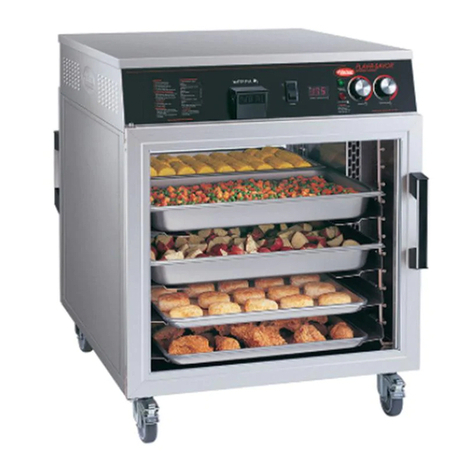
Hatco
Hatco FLAV-R-SAVOR FSHC-6W Series Installation and operating manual
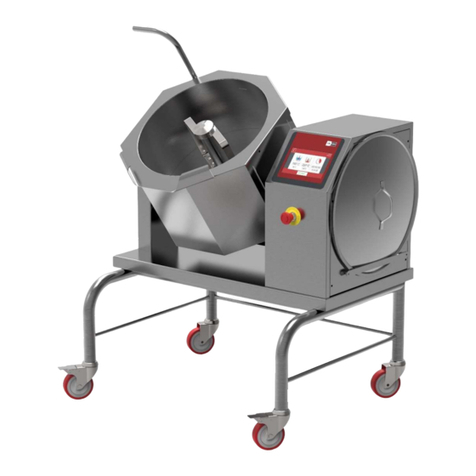
Firex
Firex CUCIMIX UCBTE008 V1 Series Installation and operation manual
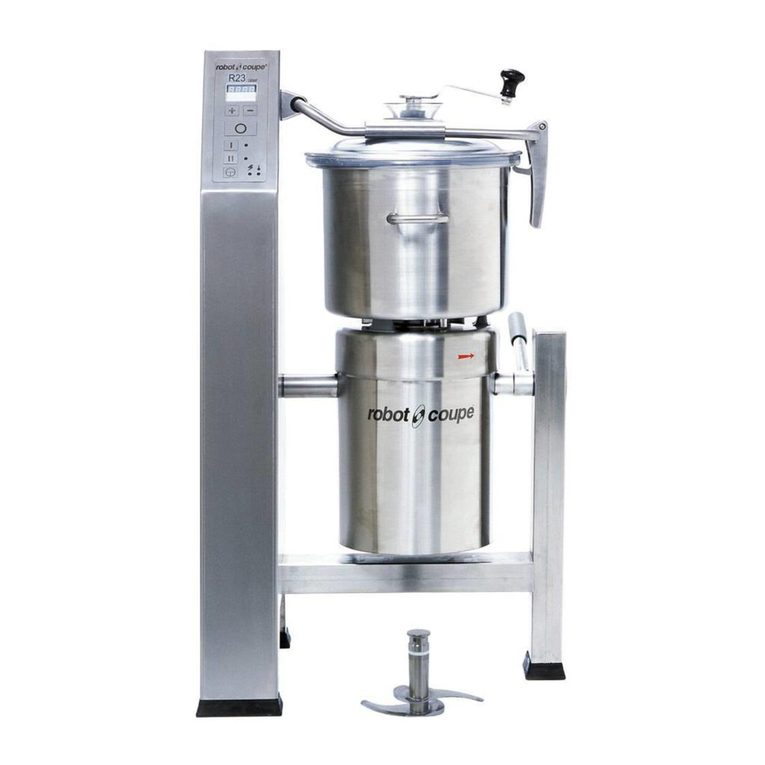
Robot Coupe
Robot Coupe BLIXER 23 Safety & Operating Instructions

Merco
Merco MHC-1 Parts & service manual
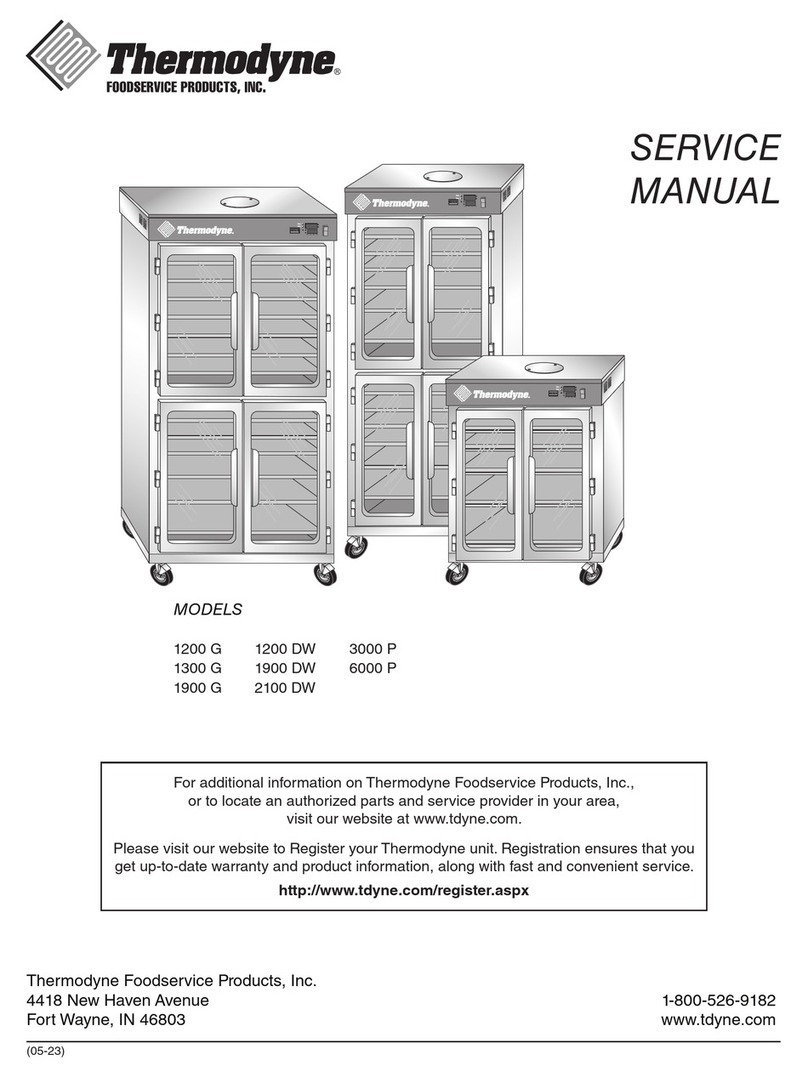
THERMODYNE
THERMODYNE 1200 G Service manual
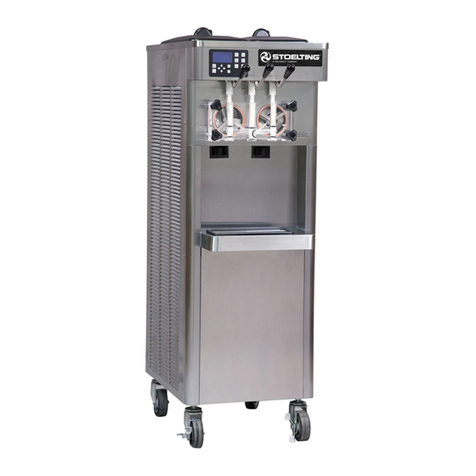
Stoelting
Stoelting F231-AD1 owner's manual

